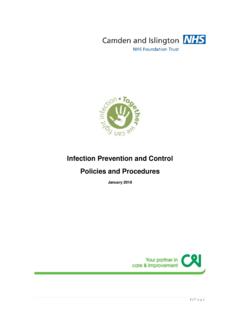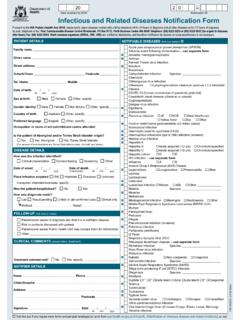Transcription of Chemical, biological, radiological and nuclear CBRN ...
1 Chemical, biological, radiological and nuclear incidents: clinical management and health protectionProtecting and improving the nation s healthChemical, biological, radiological and nuclear incidents handbook2 Chemical, biological, radiological and nuclear incidents handbook3 Chemical, biological, radiological and nuclear incidents: clinical management and health protectionGent N, & Milton R, incidents: clinical management & health ed. London: Public Health England; Publications gateway number 2018080 Chemical, biological, radiological and nuclear incidents handbook4 Executive summary 7 Incident Management Principles Immediate incident management for first responders 10 Step 1, 2, 3+ incident scene triggers for emergency personnel ..10 Medical Emergency Response Incident Teams (MERIT) and Hazardous Area Response Teams (HART) ..11 Initial triage ..12 Incident scene priorities ..12 Personal protective equipment (PPE) ..13 Decontamination of casualties ..14 Infection control 16 Standard precautions prevention of contact transmission.
2 16 Droplet spread disease precautions ..17 Aerosol spread disease precautions ..18 Suspect packages and parcels ..20 Emergency contacts template 22 Incident management records 24 Chain of evidence documentation 26 Chemical ThreatsDiagnosis and early management in chemical incidents 30 Recognising the release of a chemical ..30 Clinical response if you know, or strongly suspect, that your patient has been involved in a chemical incident ..30 Public health response if you know, or strongly suspect, that your patient has been involved in a chemical incident ..30 Evaluating rapidly evolving chemical exposure syndromes ..32 Understanding chemical hazard labels 33 Exposure Limit Values 37 Recognition and Management of Specific Chemicals and Toxidromes 39 Nerve agent (organophosphate poisons) ..39 Toxic industrial chemicals Chlorine (Cl2) and other irritant gasses ..42 Incapacitating agents (anticholinergics / volatile anaesthetics / opioids including fentanyls / psychotropics).
3 44 Riot control agents (tear gas / CS gas / pepper spray / mace) ..46 ContentsChemical, biological, radiological and nuclear incidents handbook5 Carbon Monoxide (CO) ..49 Hydrogen cyanide (HCN) and cyanide salts ..51 Hydrogen fluoride (HF) / hydrofluoric acid ..54 Hydrogen Sulphide (H2S) ..56 Phosgene (COCl2) ..58 Phosphine (PH3) ..60 Sulphur mustard ..62 Toxins (ricin and abrin) ..64 Biological threats Biological agents: syndromes and differential diagnosis 68 Deliberate release incidents, recognition & response.. 68 Differential diagnosis of unusual infections ..71 Microbiological testing ..73 Pre and post exposure prophylaxis ..74 Recognition and Management of Specific Biological Agents 77 Anthrax ..77 Botulism ..80 Brucellosis ..82 Glanders ..84 Plague ..86Q Fever ..88 Coronavirus infections , severe acute respiratory syndrome (SARS) and Middle Eastern respiratory syndrome (MERS) ..90 Shiga-toxin producing Escherichia coli (STEC) ..93 Smallpox ..95 Tularemia ..98 Venezuelan equine encephalitis (VEE).
4 101 Viral haemorrhagic fever (VHF) ..103 Radiation threatsRadiation Facts 108 Ionising radiation ..108 Exposure and contamination ..109 Measuring radioactivity and radiation ..109 Radiation doses and dose limits ..110 Chemical, biological, radiological and nuclear incidents handbook6 Radiation injuries 111 Management of acute radiation injuries.. 112 Post recovery management ..113 Staff safety and patient management priorities during a radiation incident ..113 Recognition and management of graded ionising radiation injuries 115 European Society for Blood and Marrow Transplantation (EBMT) clinical scoring guide ..115 Assessment of large groups of individuals exposed to an ionising radiation source ..116 Managing EBMT score I patients ..117 Managing EBMT score II patients ..118 Managing EBMT score III patients ..120 Mass Casualty GuidelinesManagement of blood-borne virus risk in victims of significant blast or multiple victim attacks creating penetrating injuries (hepatitis B, C and HIV) 123 Antibiotic prophylaxis guidance for bomb blast victims 127 Antimicrobial prophylaxis for suspected exposure to deliberate release of a bacterial agent (anthrax, plague, tularemia) 135 Management of potential injury to hearing following an attack involving blast 139 Management of potential brain injury following an attack Involving blast 143 MRI following an attack involving bomb blast or bullet wounds 145 Chemical, biological, radiological and nuclear incidents handbook7 Executive summaryThis is the first full revision of a suite of advice originally published in 2006 by the Health Protection Agency, a predecessor body of Public Health England, under the title CBRN incidents: clinical management and health protection.
5 This new edition updates the chemical and biological guidance given in the 2006 edition and adds additional material on a range of new and emerging threats in these radiation incident response section has been completely re-written to integrate the well-established European Society for Blood and Marrow Transplantation s rapid clinical assessment tool with care pathways derived from the WHO global consensus guidelines on radiation materials have also been included concerning the health protection elements of response to mass casualty incidents including hearing loss, blood-borne virus transmission, antibiotic prophylaxis for bomb injury wounds and screening for cognitive audience for this publication remains to be first responders, emergency departments and public health and health protection have retained the system of keeping the disease, syndrome, or agent specific advice sheets as being capable of being used as standalone items that can be printed out and used to inform staff responding to identified publication is the product of the advice and guidance offered by very many colleagues from the United Kingdom s National Health Service, Defence Medical Services, and Public Health England.
6 The guidelines on the management of chemical casualties was reviewed by colleagues from the UK s National Poisons Information Service; and the contents of the whole document approved by National Health Service England s Emergency Preparedness and Response Clinical Reference editors and principal authors wish to thank all of these colleagues, too numerous to list individually, for all their help and , biological, radiological and nuclear incidents handbook8 Incident Management PrinciplesChemical, biological, radiological and nuclear incidents handbook10 Immediate incident management for first responders Step 1, 2, 3+ incident scene safety triggers for emergency personnelWhen the cause of an incident is unknown, emergency personnel should use these safety 1 One casualtyApproach using NORMAL procedures CBRN contamination unlikelyStep 2 Two casualtiesApproach with CAUTION, consider all options CBRN contamination possibleReport on arrival, update controlIf possible or suspected, follow advice for STEP 3 Step 3+Three casualties or moreDO NOT APPROACH CBRN INCIDENT CONTAMINATION LIKELYI dentify hazardsControl sceneGive METHANE report as soon as possibleDirect ambulant casualties to place of safetyMake risk assessment and provide help to non-ambulant casualties if benefit outweighs risk using minimum personnel & appropriate PPE do NOT compromise your own safety or that of your colleagues or the public remember that the emergency services have staff trained and equipped to deal with CBRN incidents establish Shared Situational Awareness using the METHANE ModelMETHANEMy call sign/major incident alertExact locationType of incidentHazards at the sceneAccessNumber of casualties and severityEmergency services present or requiredChemical, biological, radiological and nuclear incidents handbook11 Medical Emergency Response Incident Teams (MERIT) and Hazardous Area Response Teams (HART)
7 MERIT teams are deployed where ambulance personnel at scene attending an incident identify a benefit of having specialist or advanced clinical care at scene. Examples include: trauma requiring advanced management of pain; advanced airway management; fracture manipulation; specialist extrication including amputation; or entrapment over an extended period advanced triage including management of deteriorating situations critical care including specialised patient monitoring chemical, biological, radiological , nuclear (CBRN) contamination or suspected contaminationMERIT teams will normally be transported to the site by the Ambulance Service. On arrival at an incident MERITs should report to the medical incident officer (MIO), or in their absence, the ambulance incident officer (AIO) for briefing. At an incident: always follow instructions from the MIO, AIO, and other emergency service personnel on site channel all requests and queries on site through the MIO protect yourself do not put your own life or health at risk to save others: - ensure that you are wearing appropriate PPE before entering the hot zone/inner cordon or approaching any casualty - ensure that you are clearly and appropriately identifiable - enter any inner cordon only through the inner cordon access point, where your entry will be logged and you will be briefed about hazards - leave any inner cordon only through the inner cordon access point, so that you can be debriefed and your departure can be loggedHART teams are deployed to support.
8 Incident response in hazardous areas (inner cordon) where working in specialised personal protective equipment is needed urban search and rescue (USAR) inland waterway operations (IWO) tactical medicine operations (TMO) where firearms may be used or public disorder is presentChemical, biological, radiological and nuclear incidents handbook12 Initial triageTriage is a dynamic, continuing process that aims to do the most for the most React to physiological effects (changes in vital signs) rather than anatomical effectsP1 LIFE THREATENINGB reathe only after airway cleared, OR, Respiratory Rate < 9/min, OR,Respiratory Rate > 30/min*, OR,Capillary Refill time > 2 sec(*note may be due to extreme anxiety)IMMEDIATE TREATMENTP2 URGENTU nable to walk, AND,Respiratory Rate 10-29/min, AND,Capillary Refill time 2 secURGENT TREATMENTP3 MINORW ounded but able to walk independentlyDELAYED TREATMENTP4 DEADNot breathing even after airway cleared NO TREATMENT(may need decontamination / special handling before removal)Incident scene priorities reduce the number of potential casualties by ensuring that.
9 - injured people are removed from the site of any chemical release if possible without risk to rescuers - uninjured people outdoors are moved upwind of any chemical release - uninjured people indoors remain in shelter with doors and windows shut - decontamination is done promptly where caustic or irritating injuries are present, or organophosphate (nerve agent) poisoning is suspected - decontamination is NOT NEEDED if the chemical agent released is a gas decontaminate IF NECESSARY according to Joint Emergency Services Interoperability Programme (JESIP) using the disrobing, and improvised dry or wet protocols for emergency decontamination radiation incidents if life-threatening injury present, treat before decontamination (including transfer to hospital if necessary) and decontaminate only after clinically stable; if no life-threatening injury, decontaminate at scene and then treat manage injuries and clinical symptoms using standard resuscitation ABCs guidance give counter-measures appropriate to first line use if indicated at the incident scene (high flow rate oxygen and atropine) record any treatment given on the triage tag attached to the casualty feedback relevant information regularly to MIO/AIO ensure that you and your equipment remain in a controlled area until decontaminated, and that you report to the MIO before you leave the siteSee also: PPE, decontamination, specific agents, diagnosis & immediate managementChemical, biological, radiological and nuclear incidents handbook13 Personal protective equipment (PPE)Overview: appropriate PPE will protect you, the patient and other patients and colleagues from infection and from other hazards, but only if selected, worn, and discarded correctly.
10 The algorithm below is designed to help you select PPE appropriate to the task don and remove PPE as you have been instructed in training. for advice on choosing and using PPE contact your infection control team (infection hazards) or for chemicals/radiation your local Health Protection Team who will liaise with national health protection experts as necessaryYes/ maybeYes/ maybeYes/ maybeYes/ maybeYes/ maybeNONONONONOHas the patient been EXPOSED to a CHEMICAL;Is decontamination needed and NOT yet been undertaken?WEAR FULL NHS CHEMICAL PPEBody, clothes, skin: chemical resistant coverall & bootsNose, mouth, lungs: chemical respirator (integral to PPE)Eyes: chemical resistant coverall with integral hoodHands: chemical resistant glovesCould this be smallpox, a viral haemorrhagic fever (VHF), or other infection (eg TB) requiring airborne infection isolation?WEAR PPE for AEROSOL SPREAD DISEASESBody, clothes, skin: full length impermeable gown, apron, hair & foot coveringsNose, mouth, lungs: FP3 respirator (fit tested/checked)Eyes: face shield, visor or gogglesHands: single disposable glovesWill/might you be exposed to patient s respiratory secretions (eg patient with cough, URTI, flu symptoms) or are you about to do a cough-provoking procedure (eg suction, intubation, NG tube, bronchoscopy)?













